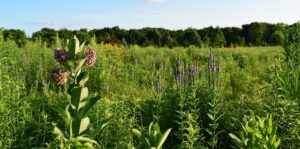AMES, Iowa—Iowa has been steadily adding new habitat for monarch butterflies over the past couple of years. The Iowa Monarch Conservation Consortium recently released its Monarch Conservation Effort Report, which offers a snapshot of monarch habitat establishment through 2020 in all 99 counties across the state.
“This report demonstrates the significant impact so far from the combined efforts of the consortium’s broad membership and partners to engage Iowans about monarch butterflies and their importance to Iowa. Its release also underscores the need for continued education, habitat creation and conservation efforts by all stakeholders,” said Daniel J. Robison, holder of the endowed dean’s chair in the College of Agriculture and Life Sciences at Iowa State University.
The report summarizes the program goals, methodology and habitat acres established through 2020. The data show that over the past six years, more than 430,000 acres of monarch butterfly habitat has been established in the state. The habitat acres already established are over halfway to the consortium strategy’s low-end goal of 790,000 by 2038.
“Monarch butterflies need habitats to live and feed during their fall migration from Canada to Mexico,” said Kayla Lyon, director of the Iowa Department of Natural Resources. “The Iowa Department of Natural Resources is proud of its partnerships with private landowners, conservation organizations, and state and local governments that contribute to monarch habitat management’s preservation efforts on larger scales in Iowa.”
The report shows how different land use sectors are doing in reaching habitat goals. Agriculture and Public Land have made the most progress and Road Rights of Way is on track to meet the 2038 goal. Habitat establishment is self-reported by individuals and organizations through the U.S. Fish and Wildlife Service managed Monarch Conservation Database (MCD), USDA’s Conservation Reserve Program and Natural Resources Conservation Service Programs, and HabiTally.
“Iowans are continuing to take steps to protect our natural resources and improve our water quality while ensuring that habitat is available for pollinators and wildlife in their communities,” said Iowa Secretary of Agriculture Mike Naig. “The Iowa Monarch Conservation Consortium’s proactive work is yielding results. As we continue to scale up and accelerate our water quality and conservation efforts, we are proud to work with public and private partners to implement conservation practices on agricultural land and within urban communities across the state.”
The consortium also premiered a new tool for community use along with the report. The Monarch Conservation Effort Dashboards are platforms that allow anyone to interact with data at the state and county level. The interactive Iowa heat map allows users to click on a county and see a pie graph of the county’s cumulative monarch habitat acres broken down by sector.
To read the report or interact with the dashboards, visit https://monarch.ent.iastate.edu/monarch-conservation-effort.
Iowa Monarch Conservation Consortium comprises members and partners from 50 organizations, including agricultural and conservation associations, agribusiness and utility companies, universities and state and federal agencies.
To learn more about the Iowa Monarch Conservation Consortium, visit iowamonarchs.info and follow @IowaMonarchs on Facebook, Twitter, and YouTube.

A new report by the Iowa Monarch Conservation Consortium shows the state is making steady progress towards goals to establish habitat for monarch butterflies. Photo courtesy of Iowa State University.

(contributed article and photo, ISUCALS)









